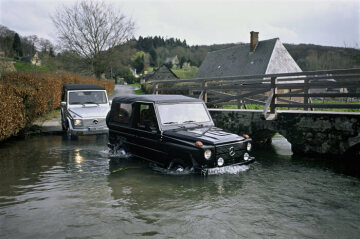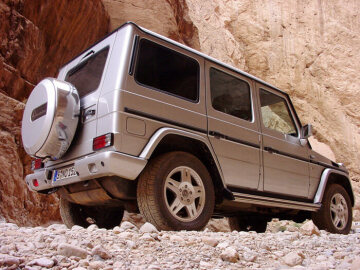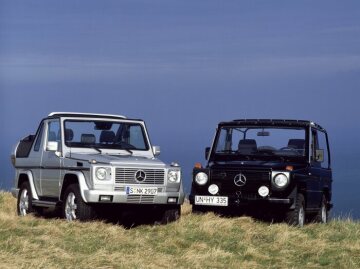In autumn 2000, Mercedes-Benz gave the 463-series G-Class, which had already been on the market for more than ten years, a comprehensive facelift. The revised models debuted at the Paris Motor Show in September 2000 with a new interior design, even more extensive standard equipment and numerous technical innovations. The most important change in the model range was the discontinuation of the G 300 Turbodiesel, whose role as the most powerful compression-ignition model was taken over by the new G 400 CDI. The engine used here was the common-rail V8 diesel engine familiar from the S-Class, which produced 184 kW/250 hp from 4.0 litres of displacement and delivered a commanding peak torque of 560 Nm.
In terms of its external appearance and gross list prices, which initially ranged from DM 149,284.59 for the convertible version to DM 146,788.95 for the long station wagon, the G 400 CDI was exactly the same as the G 500, which until then had been the sole top model in the series. With regard to driving performance, the diesel- and petrol-powered top models also showed almost identical values. Both stood out externally with particularly elegant design elements, such as silver-painted 18-inch light-alloy wheels with shiny wheel covers, chrome crossbars in the radiator grille and bumpers painted in the vehicle colour.
The focus of the facelift was on further optimising long-distance comfort and functionality. Thus, in addition to modified door trims, the G-Class also received a redesigned instrument panel with modern switches, a clearly arranged instrument cluster and a practical centre console, which also included an armrest and a stowage compartment between the front seats. Also on board was a newly developed, sensor-controlled automatic climate control system with separate temperature control for the driver and front passenger sides, swivelling rear air vents and a high-performance dust pollen filter. The newly designed front seats with electric fore/aft and height adjustment as well as the electrically adjustable steering column – both with memory function as standard – also increased the comfort level. Further equipment features of the facelifted G-Class were light and windscreen wiper sensors as well as the automatically dimming inside mirror, which was also part of the standard equipment.
The innovative COMAND control and display system first presented in the S-Class in autumn 1998, which combined car radio, CD player, navigation system, TV receiver and other functions in one unit, could now also be ordered for the G-Class. It was standard equipment on both V8 models. New was the availability of state-of-the-art telematics services, for example dynamic route guidance based on current traffic information, the TELEAID automatic emergency call system and the TELEDIAGNOSTICS service. In conjunction with TELEAID, the innovative LINGUATRONIC voice control was also optionally available for the first time, with which the car phone and audio devices could be controlled.
At the International Motor Show (IAA) in Frankfurt/Main in September 2001, Mercedes-Benz presented the G 270 CDI as a new diesel-powered base model. The high-torque 2.7-litre five-cylinder engine with common-rail direct injection, which Mercedes-Benz also offered in the C-, E- and M-Class, was calibrated to 115 kW/156 hp in the G 270 CDI and provided a maximum torque of 400 Nm from 1800 rpm. The main reason for the remarkable performance data was the use of a so-called VTG exhaust gas turbocharger (variable turbine geometry), whose guide vanes adjusted according to the load condition of the engine. The G 270 CDI, which was launched at the beginning of 2002, was only available as a station wagon with short or long wheelbase; the convertible version was not offered. Gross list prices for the entry-level diesel model started at 50,228.00 euros.
Other innovations introduced at the time of the IAA included electronic control systems as standard equipment to enhance driving safety. From September 2001, for example, all G-Class models were equipped with the Electronic Stability Program ESP® and BAS Brake Assist. In parallel, the all-wheel drive, also standard, was perfected through the use of the electronically controlled 4-ETS traction system, which had been used for the first time in the Mercedes-Benz M-Class. This dynamic handling control system improved grip when starting and accelerating on slippery surfaces such as in the wet or on black ice by automatically braking one or more wheels that had lost traction, thus increasing the propulsive power at the wheels with better traction.
Even after the successful market launch of the M-Class, which from 1997/98 had helped to establish the innovative vehicle genre of "luxury sport utility vehicles" (SUVs), the classic G-Class, positioned primarily as an off-road vehicle, retained its firm place in the Mercedes-Benz model range and continued to find numerous buyers all over the world with its special talents. In 2001, sales figures even increased by more than 60 per cent, which was not least due to the successful market launch in the USA from October 2001.
The top-of-the-range G 55 AMG model, which now had a larger engine and was only available on special request, also contributed to the good sales results. Based on the regular G 500, it could still only be configured by separately ordering the AMG technology package and was not listed in the general sales literature. Thanks to the lengthened stroke, the naturally aspirated V8 engine of the M 113 series now had a displacement of 5439 cc, resulting in an increase in output to 260 kW/354 hp. The maximum speed of the AMG version, which still had the characteristic exhaust system with two individual tailpipes exiting in front of the rear wheels, was electronically limited to 210 km/h.
Three years later, in 2004, to coincide with the 25th anniversary of the Mercedes-Benz G-Class, this special position came to an end and the AMG model was henceforth established as a substantial part of the standard product range. This change took place with the G 55 AMG Kompressor with a further massive increase in performance. Thanks to the use of a mechanical supercharger, the power output of the 5.5-litre V8 increased from the previous 260 kW/354 hp to 350 kW/476 hp and a peak torque of 700 Nm – figures that further underpinned the top model's singular market position. Available exclusively as a station wagon with long wheelbase, the gross list price of the AMG version was initially 108,228.00 euros.
To mark the production anniversary, the extensively equipped special "Limited Edition" model was also launched on the German market, which was listed on the world market as the "Classic 25". Otherwise, the G-Class range offered in Germany at this time included the G 270 CDI, available as a short and long station wagon, the G 400 CDI, available in all three versions as a particularly powerful diesel-powered model, the petrol-powered G 320, which continued to deliver 158 kW/215 hp, and the G 500 – both also available as a convertible, short station wagon and long station wagon – as well as the new G 55 AMG Kompressor. All V8 petrol engines were now certified according to the Euro 4 standard. Furthermore, the suspension set-up of the more powerful models had been revised and the steering gear generally improved. In addition, all station wagons with long wheelbase now had window airbags, while the vehicle variants with short wheelbase were now only designated as four-seaters.
In 2005, after 26 years of production, a ground-breaking decision was made at Mercedes-Benz: The G-Class was to remain in the range. In view of constantly tightening approval regulations, for example in the context of pedestrian protection and emissions provisions, the question had been whether and how to remain loyal to this unique vehicle in the future. One of the decisive factors for the positive vote was the unchanged great popularity of the G-Class worldwide. Since 1979, more than 185,000 vehicles had been built at the production site in Graz.
After this positive policy decision, the tradition-rich model series started the year 2006 with a special model called "Grand Edition". Available for the G 400 CDI and G 500 in long station wagon specification, the specially compiled equipment package included, among other things, the special allanite grey magno paint finish (a matt silver metallic shade), exclusively designed 18-inch light-alloy wheels with high-sheen finish, a set of trim strips in brushed aluminium with integrated "Grand Edition" lettering and a spare wheel cover in stainless steel. The interior was upgraded with black genuine leather seats, matt genuine oak wood trim, illuminated door sill panels and edition badges on the centre console and front seats.
In the summer of that year, the model range was also refocused once again: On the one hand, the G 320 CDI was presented as a new model, which was equipped with a diesel engine of the latest generation. The 3.0-litre V6 engine of the OM 642 series delivered 165 kW/224 hp and, with a diesel particulate filter as standard, also met the strict exhaust emission limits of the Euro 4 standard. The engine was combined with the 7G-TRONIC seven-speed automatic transmission, which had been tried and tested in the E-Class and S-Class, among other models, since 2003. Thanks to its high performance and conservative fuel consumption, the G 320 CDI replaced both the G 270 CDI and the V8-powered G 400 CDI. The standard equipment of the new model included bi-xenon headlamps and fog lamps with cornering lights. Gross list prices at market launch were set at 69,948.00 euros for the convertible, 64,148.00 euros for the short station wagon and 69,020.00 euros for the long station wagon.
On the other hand, also in the summer, the petrol-powered G 320, which has been on sale since 1997, was removed from the range. At the same time, the G 55 AMG Kompressor, which was positioned at the top end of the model range, received a further injection of power, after which the 5.5-litre V8 engine now mobilised 368 kW/500 hp, with an unchanged maximum torque of 700 Nm. With the top speed still limited to 210 km/h, this next stage in the AMG model's ongoing kW/hp evolution resulted in a shortened 0–100 km/h sprint time of 5.5 seconds. From September onwards, the sharpened high-performance version was available in the showrooms for a gross list price of 113,332.00 euros. The petrol-powered range thus only included models with superior eight-cylinder engines.
The next revision of the G-Class followed in spring 2007. The focus was now on the cockpit, where four analogue round instruments framed by chrome rings set modern design accents. The four-spoke multifunction steering wheel, covered in leather as standard in the G 320 CDI and in a wood/leather version in the G 500 and the G 55 AMG Kompressor, also featured a new design. All three models benefited from a modified centre console with new controls and switches for the air conditioning and comfort functions. It not only represented a visual upgrade, but also improved operating safety. The COMAND APS control and display unit, with its enhanced functionalities, was standard equipment in the G 500 and G 55 AMG Kompressor models, and could be ordered as special equipment in the G 320 CDI. The update also introduced new optional extras, such as a reversing camera and tyre pressure monitoring. From the outside, the vehicles of the refreshed G-Class were recognisable by the oval design of the LED-look tail lamps.
A special G-Class was delivered to the Vatican in December 2007: The head of the Roman Catholic Church had wanted an open-top presentation vehicle for use in nice weather. The new "Popemobile", built on the basis of the G 500, was equipped with a fold-down windscreen and grab bars and, like its predecessors, was painted in the Vatican mystic white. The Pope entered the convertible, which was also white on the inside, via red-carpeted steps in the rear and completed his audience on wheels standing up so as to be clearly visible to the crowd.
There were no further significant changes to the vehicles or the sales range of the G-Class of the 463 series until the next extensive model update, which was planned for 2008.











































